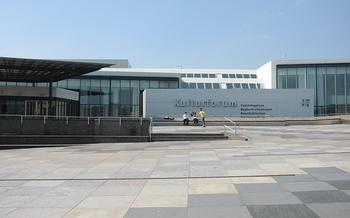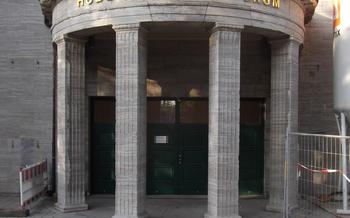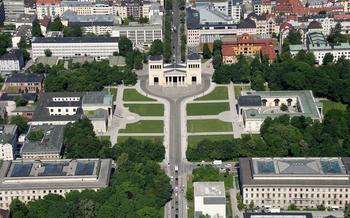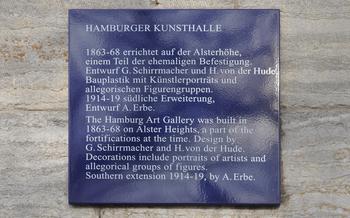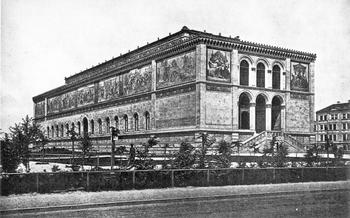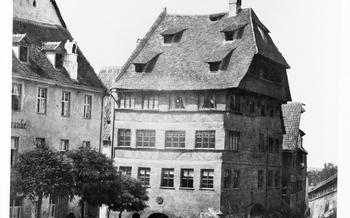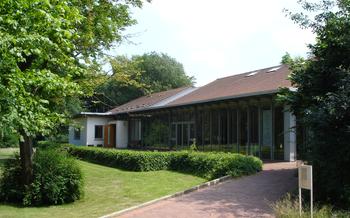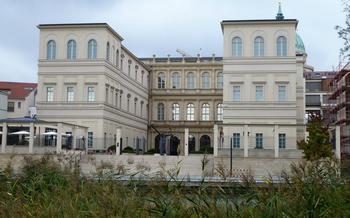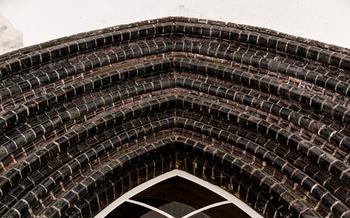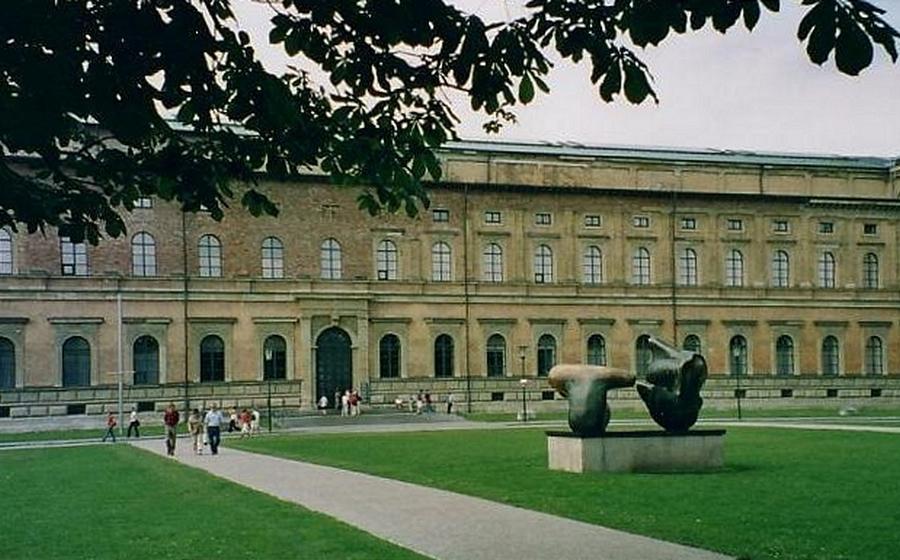
Alte Pinakothek
- Masterpieces from the Middle Ages:
- The Dürer Collection
- The Italian Renaissance:
- The Dutch Golden Age:
- The Flemish Masters:
- The German Renaissance:
- Baroque and Rococo Art
- The 19th Century: Romanticism and Realism
- The Modern Era:
- Special Exhibitions
- Educational Programs
- The Museum Shop
Masterpieces from the Middle Ages:
Step into the realm of medieval art at the Alte Pinakothek. The museum houses an impressive collection of works from the 14th to 16th centuries, showcasing the diverse styles and techniques of the era. Among the highlights are masterpieces by Albrecht Dürer, whose intricate engravings and woodcuts depict religious and mythological scenes with remarkable precision. Another notable artist is Lucas Cranach the Elder, whose vibrant paintings capture the essence of the German Renaissance. Explore works that delve into religious themes and mythological narratives, offering a glimpse into the beliefs and values of the time. Discover the stories behind each piece, and marvel at the craftsmanship and artistry that bring these centuries-old works to life.
The Dürer Collection
The Alte Pinakothek boasts an extensive collection of works by Albrecht Dürer, one of the most celebrated artists of the German Renaissance. Dürer's paintings, drawings, and engravings offer a comprehensive insight into his artistic journey and innovative techniques.
Among the must-see pieces is Dürer's renowned self-portrait, capturing his likeness with meticulous detail and revealing his introspective nature. Another highlight is the "Four Apostles," a series of paintings depicting the evangelists Matthew, Mark, Luke, and John. These works showcase Dürer's mastery of anatomy and his ability to convey emotion through facial expressions and gestures.
Furthermore, the collection includes a variety of Dürer's religious works, such as the "Adoration of the Magi" and the "Lamentation of Christ." These pieces demonstrate his deep understanding of Christian iconography and his ability to create moving and evocative scenes. Dürer's intricate engravings, including the famous "Knight, Death, and the Devil" and the "Melancholia I," are also on display, showcasing his exceptional skill in printmaking.
The Italian Renaissance:
The Alte Pinakothek boasts an impressive collection of Italian Renaissance paintings, showcasing the works of some of the most celebrated masters of the era. Sandro Botticelli, the Florentine painter known for his graceful and lyrical style, is represented by several works, including the enchanting "Venus and Mars" and the serene "Madonna of the Magnificat." Raphael, the High Renaissance master, is represented by the delicate "Madonna della Tenda," while Titian, the Venetian master of color and sensuality, is represented by the vibrant "Venus of Urbino."
In addition to these iconic works, the Alte Pinakothek also houses a number of lesser-known gems from the Italian Renaissance. Look for the delicate and atmospheric "Saint Jerome in the Wilderness" by Giovanni Bellini, the expressive "Ecce Homo" by Antonello da Messina, and the richly detailed "Adoration of the Magi" by Gentile Bellini. These works offer a glimpse into the diverse range of styles and approaches that characterized the Italian Renaissance, and provide a fascinating counterpoint to the more familiar works by the great masters.
The Dutch Golden Age:
The Alte Pinakothek's collection of Dutch Golden Age paintings offers a remarkable glimpse into the artistic achievements of the 17th century Netherlands. This period, often referred to as the Golden Age, saw a flourishing of art, culture, and trade in the Dutch Republic. The paintings from this era capture the essence of Dutch society, showcasing the country's wealth, diversity, and love of life.
Artists like Rembrandt van Rijn, Johannes Vermeer, and Frans Hals are among the most celebrated masters of this period. Rembrandt's "The Anatomy Lesson of Dr. Nicolaes Tulp" is a masterpiece of chiaroscuro, capturing the drama and intensity of a medical dissection. Vermeer's "The Art of Painting" provides a glimpse into the artist's studio, revealing his meticulous technique and mastery of light and shadow. Hals's "The Laughing Cavalier" exudes a sense of joy and vitality, embodying the exuberant spirit of the Golden Age.
Dutch Golden Age paintings often depict scenes from everyday life, offering a fascinating window into the customs and traditions of the time. Genre scenes, such as those by Jan Steen and Adriaen Brouwer, capture the humor and folly of daily life. Landscapes, such as those by Jacob van Ruisdael and Meindert Hobbema, evoke the beauty and serenity of the Dutch countryside. Portraits, such as those by Frans Hals and Judith Leyster, reveal the character and individuality of the Dutch people.
The realism and technical virtuosity of Dutch Golden Age paintings are striking. The artists' ability to capture light, texture, and detail is unparalleled. Their works continue to inspire and captivate viewers, making the Dutch Golden Age collection at the Alte Pinakothek a must-see for any art enthusiast.
The Flemish Masters:
The Alte Pinakothek boasts an impressive collection of works by the Flemish masters, who played a pivotal role in the development of oil painting and realism in the 15th and 16th centuries. Among the highlights is Jan van Eyck's "The Ghent Altarpiece", a monumental polyptych that showcases the artist's meticulous attention to detail and mastery of perspective. Another must-see is Pieter Bruegel the Elder's "The Peasant Wedding", a vibrant depiction of Flemish village life filled with humor and symbolism. These works, along with others by Rogier van der Weyden, Hieronymus Bosch, and Hans Memling, offer a glimpse into the rich and complex artistic traditions of Flanders during this period.
The German Renaissance:
The Alte Pinakothek also houses a significant collection of works from the German Renaissance, which flourished during the 16th and 17th centuries. This period was marked by a renewed interest in classical antiquity and a shift towards more secular subject matter.
-
Albrecht Altdorfer: Altdorfer's paintings often depicted landscapes with religious or mythological themes. His work "The Battle of Alexander at Issus" is a stunning example of his ability to combine historical and mythical elements in a single composition.
-
Hans Holbein: Holbein was a master of portraiture, and his works are renowned for their realism and attention to detail. His portraits of Henry VIII and his family are among the most famous works of the German Renaissance.
Baroque and Rococo Art
The Alte Pinakothek's Baroque and Rococo collection is a feast for the eyes. This period, spanning the 17th and 18th centuries, saw a dramatic shift in artistic style, characterized by dynamic compositions, rich colors, and an abundance of decorative elements.
Among the highlights of the collection are works by the Flemish master Peter Paul Rubens, whose vibrant paintings burst with energy and movement. His "Descent from the Cross" is a powerful depiction of Christ's removal from the cross, while "The Massacre of the Innocents" showcases his exceptional ability to convey emotion and drama.
Another Baroque standout is Gian Lorenzo Bernini's "Apollo and Daphne," a marble sculpture that captures the moment when the god Apollo pursues the nymph Daphne, who transforms into a laurel tree. The intricate details and expressive gestures of the figures convey a sense of movement and transformation.
From Italy, we move to Venice and the works of Giovanni Battista Tiepolo, whose ceiling frescoes and paintings are renowned for their illusionistic effects and vibrant colors. His "The Martyrdom of Saint Bartholomew" is a breathtaking example of his mastery, depicting the saint's martyrdom with dramatic lighting and swirling clouds.
These Baroque and Rococo masterpieces, with their dynamic compositions and emotional intensity, offer a glimpse into a period of artistic exuberance and innovation.
The 19th Century: Romanticism and Realism
The 19th century marked a period of significant cultural and social change in Germany, which was reflected in the art of the time. Romanticism, with its emphasis on emotion, imagination, and the individual, was a dominant movement in the early part of the century. Landscapes, portraits, and historical scenes were popular subjects, often imbued with a sense of melancholy and longing. Caspar David Friedrich's "The Wanderer above the Sea of Fog" is a quintessential example of Romantic painting, capturing the solitary figure contemplating the vastness of nature.
Realism, which emerged in the latter half of the century, focused on depicting everyday life and social issues with accuracy and objectivity. Adolph Menzel's "Iron Rolling Mill" is a powerful depiction of industrial labor, capturing the harsh reality of working conditions during the Industrial Revolution. These works not only documented the changing face of Germany but also served as social commentary, reflecting the concerns and aspirations of the time.
The Modern Era:
The Alte Pinakothek also houses a significant collection of works from the late 19th and early 20th centuries, showcasing the transition from traditional styles to modern art movements. Among the notable artists represented are Franz Marc, Wassily Kandinsky, and Ernst Ludwig Kirchner.
-
Franz Marc: Marc's paintings often featured animals as subjects, imbued with symbolism and emotional depth. His vibrant colors and simplified forms reflect his connection to the Expressionist movement.
-
Wassily Kandinsky: A pioneer of abstract art, Kandinsky's works moved away from recognizable forms, instead using colors and shapes to convey emotions and ideas. His groundbreaking compositions laid the foundation for abstract expressionism.
-
Ernst Ludwig Kirchner: Kirchner was a key figure in the Die Brücke group, an influential expressionist movement. His paintings often depicted urban scenes and landscapes, characterized by bold colors, simplified forms, and psychological intensity.
These modern masters challenged traditional notions of representation, paving the way for new artistic expressions that would shape the world of art in the 20th century. Their works at the Alte Pinakothek offer a glimpse into the transformative period in art history.
Special Exhibitions
The Alte Pinakothek regularly presents special exhibitions, offering visitors the chance to delve deeper into specific themes or artists not represented in the permanent collection. These exhibitions are often organized in collaboration with other museums and institutions, bringing together works from different collections to create unique and immersive experiences.
Past special exhibitions have explored topics such as the Renaissance in Florence, the Dutch Golden Age, and the work of individual artists like Rembrandt and Van Gogh. Upcoming exhibitions may focus on contemporary art, modernism, or lesser-known movements and periods.
By presenting these special exhibitions, the Alte Pinakothek aims to provide visitors with a fresh perspective on art history and to showcase the diversity and richness of its collection. It's worth checking the museum's website or social media channels for announcements of upcoming exhibitions to plan your visit accordingly.
Educational Programs
The Alte Pinakothek offers a range of educational programs to enhance visitors' understanding and appreciation of art. Workshops and lectures by experts in art history provide in-depth insights into specific artists, movements, and techniques. These programs are designed for both casual art enthusiasts and serious students, offering a deeper dive into the museum's collection.
Family programs and activities cater to younger visitors, encouraging them to engage with art in a fun and interactive way. Hands-on activities, storytelling sessions, and creative workshops spark children's imagination and help them develop a lifelong appreciation for art.
Interactive exhibits and multimedia experiences bring the collection to life. Touchscreens, digital displays, and augmented reality applications allow visitors to explore artworks in new and engaging ways. These interactive elements enhance the museum experience, making it more accessible and enjoyable for visitors of all ages.
The Alte Pinakothek's educational programs not only provide knowledge and insight but also foster a sense of community and dialogue around art. By encouraging visitors to actively engage with the collection, the museum promotes a deeper understanding and appreciation of the diverse masterpieces it houses.
The Museum Shop
The Alte Pinakothek offers a well-stocked museum shop where you can find a wide range of art-related merchandise to enhance your visit and take a piece of the museum's collection home with you. Browse through a carefully curated selection of art books, featuring in-depth analyses of the museum's masterpieces and the broader history of art. Discover high-quality prints and reproductions of your favorite paintings, allowing you to bring the beauty of the Alte Pinakothek into your own space.
For a more personal touch, choose from a variety of postcards featuring iconic works from the collection. These make for thoughtful souvenirs or greetings to share with friends and family. You'll also find a delightful array of other souvenirs, including magnets, keychains, and decorative items inspired by the museum's treasures.
Whether you're looking for a unique gift for an art enthusiast or a special memento of your visit, the Alte Pinakothek's museum shop has something for everyone. By making a purchase, you not only support the museum's mission and conservation efforts but also contribute to preserving and sharing its remarkable collection with future generations.
